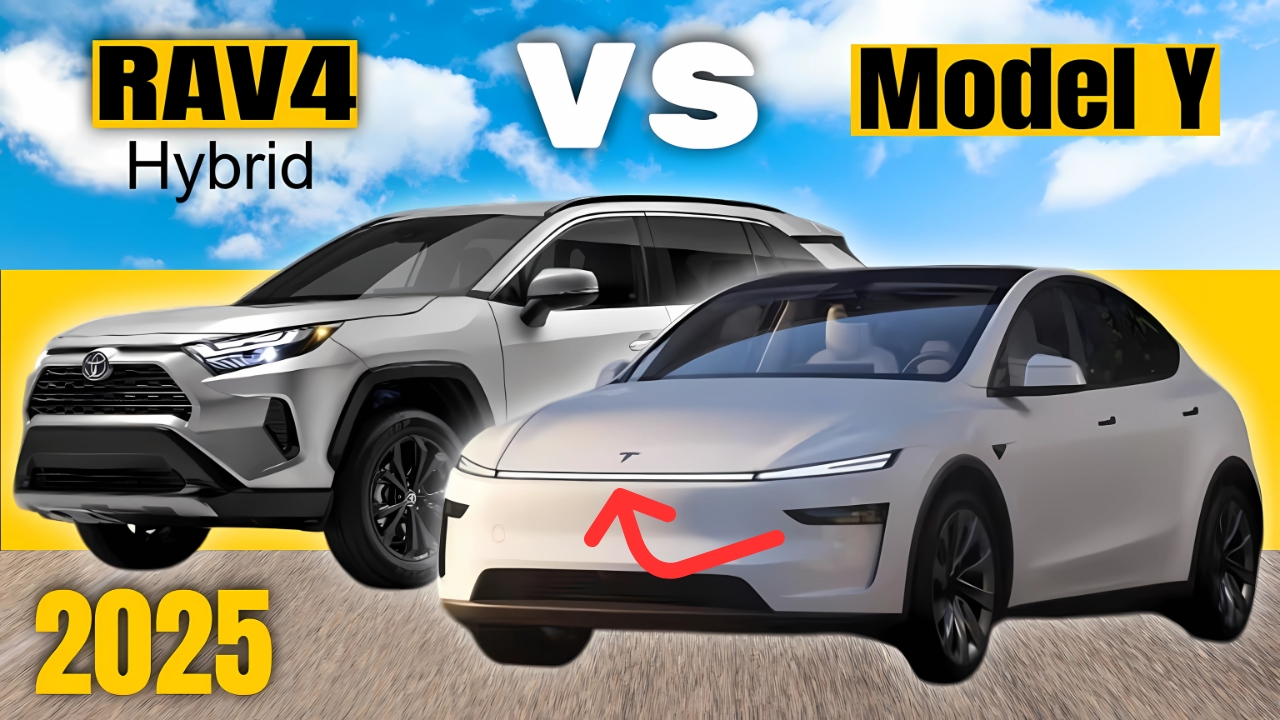RAV4 Hybrid vs. Model Y EV: Shopping for an efficient SUV that won’t break the bank? You’ve probably landed on two popular choices: the Toyota RAV4 Hybrid and the Tesla Model Y.
Both promise impressive efficiency, but they take completely different approaches to get there. One relies on tried-and-true hybrid technology, while the other goes all-in on electric innovation.
Let’s break down what each vehicle offers so you can decide which fits your lifestyle better.
The Efficiency Showdown
When it comes to efficiency, both vehicles excel, but the numbers tell different stories. The RAV4 Hybrid delivers an EPA-estimated 41 mpg city, 38 mpg highway, and 39 mpg combined, which translates to real-world savings at the pump. During real-world testing, it achieved 37 mpg on a 200-mile highway route, just 1 mpg shy of its EPA rating.
The Tesla Model Y operates on a different scale entirely, with the Long Range RWD offering up to 337 miles of range and 125 MPGe combined, while the AWD version provides 311 miles of range at 117 MPGe. What’s MPGe? It’s how electric vehicles measure efficiency – essentially how far you can travel using the energy equivalent of one gallon of gasoline.
Here’s where it gets interesting: the EPA indicates Model Y owners can expect to save up to $5,750 in fuel costs over five years, spending about $600 on electricity annually. Meanwhile, RAV4 Hybrid owners still visit gas stations, though much less frequently thanks to that stellar 39 mpg combined rating.
Innovation: Two Different Philosophies
The innovation gap between these vehicles is massive, but not necessarily in ways you’d expect.
Tesla’s approach centers on cutting-edge technology. The refreshed 2025 Model Y includes a 15.4-inch touchscreen, an 8-inch rear entertainment screen, ventilated seats, acoustic glass, and over-the-air software updates that continuously add new features. It can charge at up to 250kW, managing a 10-80% top-up in well under 30 minutes at Tesla Supercharger stations.
The RAV4 Hybrid takes a more conservative innovation approach. It combines a 2.5-liter four-cylinder engine with three electric motors, producing 219 horsepower with all-wheel drive standard. The system offers multiple driving modes including Eco Mode, EV Mode, Sport Mode, Trail Mode, and Normal Mode to match different driving needs.
While the Tesla dazzles with futuristic tech, the RAV4 focuses on proven reliability and gradual improvements. Toyota is taking an “if it ain’t broke, don’t fix it” approach, keeping the RAV4 Hybrid largely unchanged for 2025.
The Price Reality Check
This is where things get really interesting. The RAV4 Hybrid starts at $31,900, while the Tesla Model Y Long Range RWD begins at $44,990. That’s a $13,000 difference upfront.
But here’s the plot twist: a fully loaded RAV4 Hybrid Limited costs $44,345, just $645 less than the base Model Y. Plus, the Model Y qualifies for a $7,500 federal tax credit, potentially making it cheaper than a loaded RAV4 Hybrid.
For budget-conscious buyers, the RAV4 Hybrid’s lower entry price remains attractive. But if you’re considering higher trims anyway, the Model Y becomes surprisingly competitive.
Real-World Practicality
Both vehicles earn high marks for daily usability, but with different strengths.
The Model Y offers more legroom (41.8 inches front, 40.5 inches rear) compared to the RAV4’s 41.0 front and 37.8 rear inches. However, the RAV4 provides more cargo space with seats up (37.6 cubic feet vs. 30.2), though both max out at 76 cubic feet with rear seats folded.
Service availability strongly favors the RAV4, with over six times as many Toyota dealers as Tesla service centers nationwide. The RAV4 comes with a five-year unlimited mileage warranty compared to Tesla’s four-year, 80,000-mile coverage.
For road trips, the vehicles offer different experiences. RAV4 Hybrid owners can refuel anywhere in minutes, while Model Y drivers need to plan around Supercharger locations but enjoy lower operating costs.
Performance and Driving Experience
The Model Y Long Range RWD produces 295 horsepower, while AWD models offer even more power. The RAV4 Hybrid’s 219 horsepower provides adequate acceleration, particularly around town where electric motor torque provides extra punch from stops.
However, the RAV4 Hybrid drives like an appliance – its mission is getting you from point A to point B as uneventfully as possible. The Model Y offers more engaging performance and that signature electric vehicle instant acceleration.
The Reliability Factor
Looking at depreciation, the RAV4 Hybrid retains significantly more value, losing 30.4% over five years compared to the Model Y’s 53.4% depreciation. This reflects buyer confidence in Toyota’s reliability reputation versus concerns about Tesla’s build quality and service network.
Maintenance costs favor the Model Y at $1,025 over five years compared to higher traditional maintenance for the RAV4 Hybrid, though exact RAV4 figures weren’t specified in available data.
Which Should You Choose?
The RAV4 Hybrid makes sense if you value proven reliability, don’t want to change your refueling habits, prefer traditional controls, and want lower upfront costs. It’s perfect for buyers who want better efficiency without the learning curve of electric vehicle ownership.
The Model Y appeals to tech enthusiasts, those ready to embrace electric driving, people who want cutting-edge features, and buyers willing to adapt to a different ownership experience. Despite the higher starting price, federal incentives and lower operating costs can make it surprisingly affordable.
Both vehicles excel at efficiency, but they represent different philosophies. The RAV4 Hybrid offers incremental improvement with familiar technology, while the Model Y represents a bigger leap toward an electric future. Your choice depends on whether you want evolution or revolution in your driveway.
